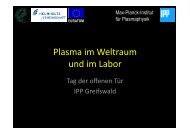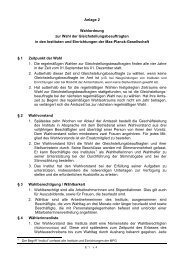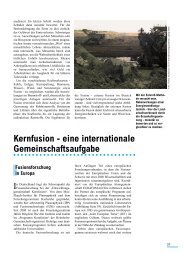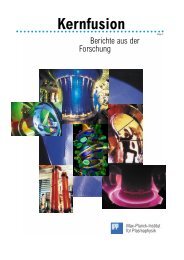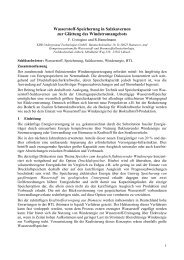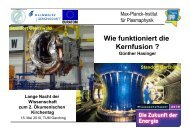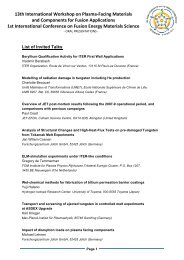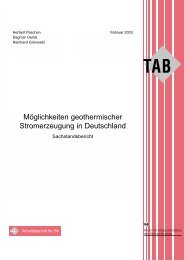IPP Annual Report 2007 - Max-Planck-Institut für Plasmaphysik ...
IPP Annual Report 2007 - Max-Planck-Institut für Plasmaphysik ...
IPP Annual Report 2007 - Max-Planck-Institut für Plasmaphysik ...
Create successful ePaper yourself
Turn your PDF publications into a flip-book with our unique Google optimized e-Paper software.
6.1 Bus-bar System<br />
The manufacturing of bus-bars continued. The first set of<br />
conductors for the first module was delivered. The manufacturing<br />
of bus-bars runs routinely. The design of mechanical<br />
supports for the bus-bar systems has been further<br />
developed. The associated drawings are partially approved.<br />
Supports had to be redesigned since several clashes with<br />
surrounding components were detected. Assembly tests<br />
with dummy bus-bars were successfully made together<br />
with FZJ. Technicians from INP in Krakow were trained for<br />
the bus-bar installation. The joint-prototype test at the<br />
Efremov <strong>Institut</strong>e was completed. The welding procedure<br />
for the bus-bar joints is finished. Practical installation exercises<br />
have started under real on-site conditions. Construction<br />
works for the current lead joint-prototype were continued.<br />
First practical works with dummies are made. These<br />
works are continued in 2008. The specification for the<br />
wiring and insulation of the quench-detection system was<br />
further developed. The qualification and delivery of insulation<br />
parts was contractually bound. Some difficulties arose<br />
at the manufacturer with respect to the proper handling of<br />
the rather liquid resin.<br />
Figure 21: 1st set of bus bars in the bus bar preparation area<br />
The bus-bar preparation was set-up, all tooling and rigs<br />
were provided and installed. Additional engineers and technicians<br />
from INP in Krakow will be trained and integrated<br />
into the bus-bar assembly team. Again problems with the<br />
aluminium welds at the coil terminals occurred. Small<br />
cracks at production proof samples were detected. The<br />
welding process was refined, however, the limits of feasibility<br />
have already been achieved. In terms of the assembly<br />
schedule more bus-bar works were moved to the preparation<br />
phase; away from the critical path. As a result additional<br />
assembly works on the bus-bar system can now be carried<br />
out without influencing the overall project time plan.<br />
Wendelstein 7-X<br />
48<br />
6.2 Vacuum Technology<br />
The work packages of the vacuum technology group in <strong>2007</strong><br />
were continued as in 2006. Main tasks were: leak detection<br />
on single components and monitoring of leak tests at suppliers<br />
(Tesla, Ensa, BNG) as well as leak and Paschen tests<br />
on coils and on cryo piping of thermal insulation during the<br />
coil preparation and assembly. The works at Tesla were<br />
finalized at the end of <strong>2007</strong>. Local leak tests with diverse<br />
test chambers for superconductor connections and cooling<br />
pipes at room temperature and at 77 K (if technically necessary)<br />
are routinely implemented during assembly. The design<br />
of these test-chambers as well as the qualification of the<br />
tests was further continued. Qualification tests of materials<br />
and devices concerning the suitability in vacuum (outgassing<br />
rates, Paschen stability) were realised in a laboratory.<br />
Little progress was achieved on the specification of the<br />
vacuum systems since it depends on the progress of the layout<br />
in the torus hall.<br />
6.3 W7-X Assembly<br />
The work in the component preparation, especially on coils<br />
and plasma vessel sectors, has been continued as planned.<br />
Components for the second module are being prepared. The<br />
works are running routinely. The scope of scanning works<br />
on these components was considerably extended. As a result<br />
additional external resources had to be hired. Additional<br />
storage capacity for prepared components outside the institute<br />
was refurbished and put into operation.<br />
Figure 22: PV sectors during the test assembly – rigs are sliding on air<br />
cushions<br />
Additional staff was hired to cope timely with the expanded<br />
preparation works. There were, however, hardly any technological<br />
changes in the coil preparation. Therefore, one can<br />
consider the qualification of the coil preparation as completed<br />
from today’s point of view. With respect to the preparation




